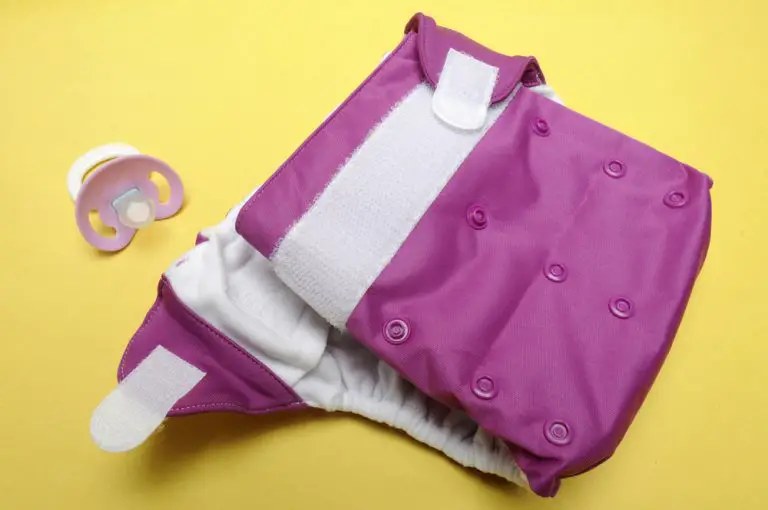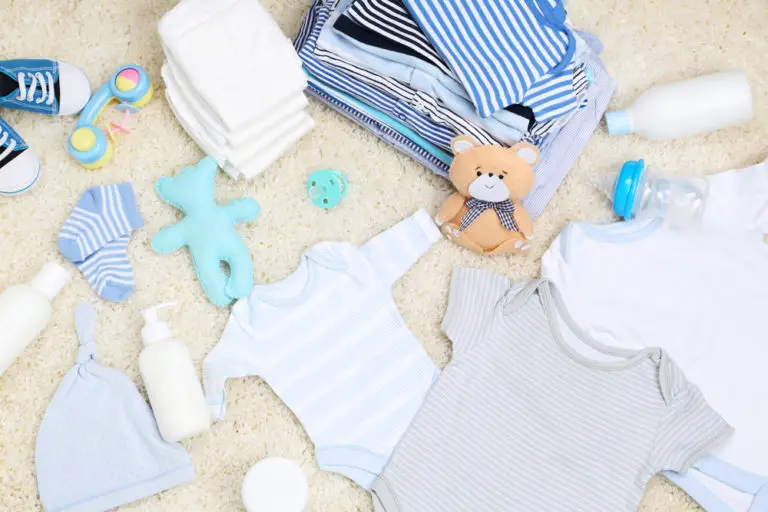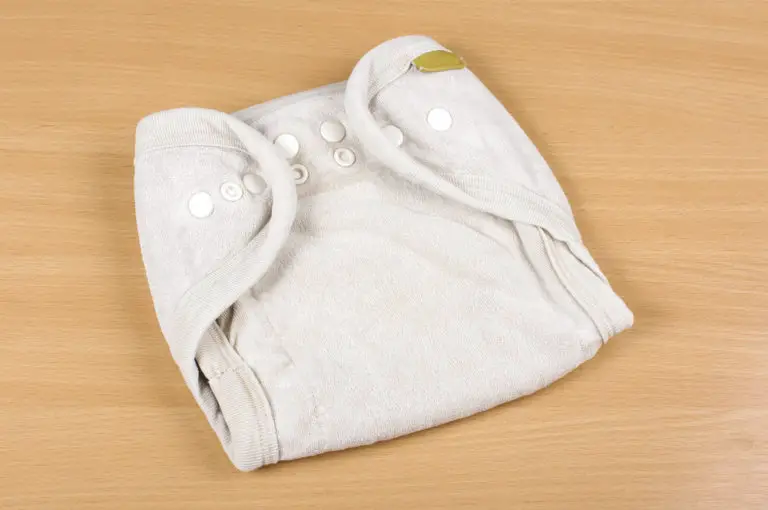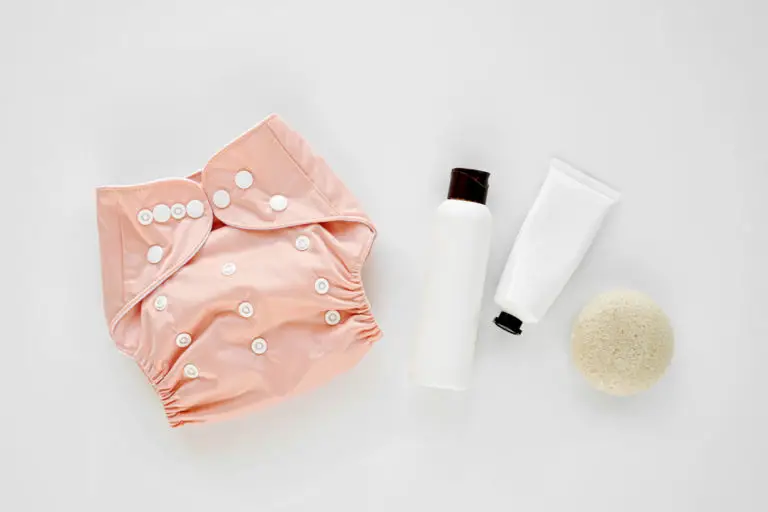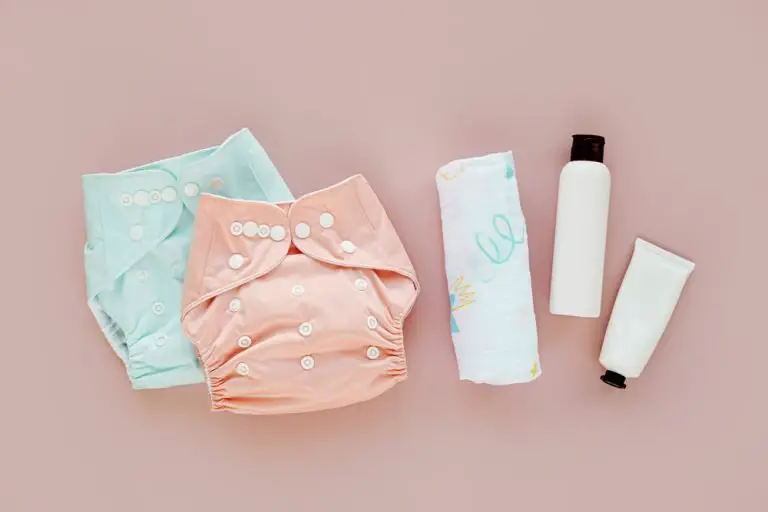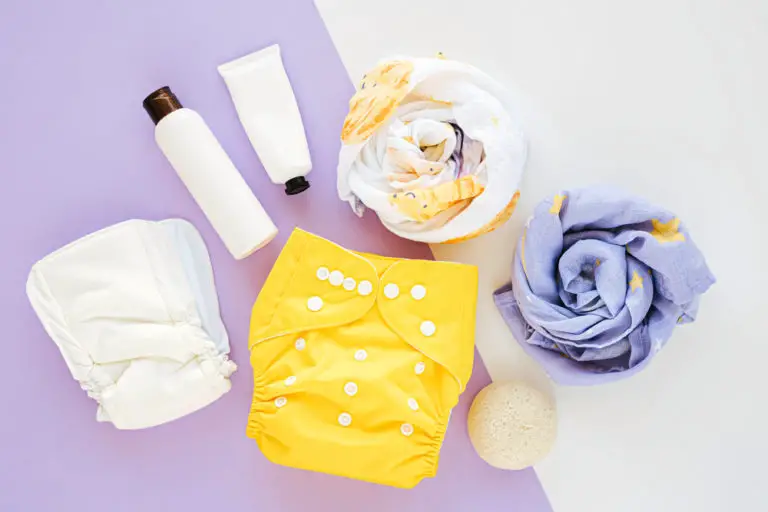12 Best Cloth Diaper Inserts in 2024 (High Absorbency)
A cloth diaper insert is your primary source of absorbency, while a doubler adds extra protection.
We use extra hemp inserts as doublers during the nighttime.
Best cloth diaper inserts are super absorbent, soft, and fast-drying.
PS! Microfiber inserts shouldn’t be placed next to your LO skin.
Our Favorites
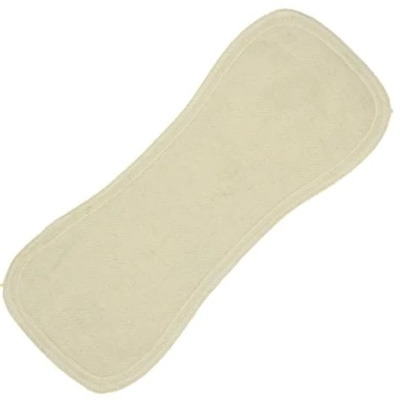
Best Cloth Inserts
Best Bottom
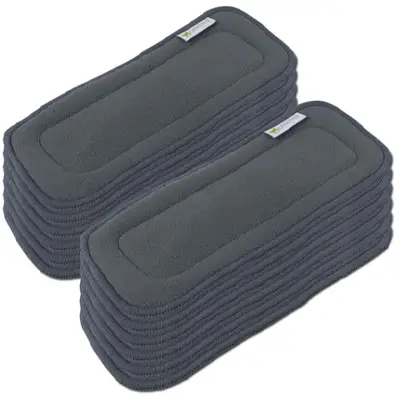
Best Charcoal Inserts
OsoCozy
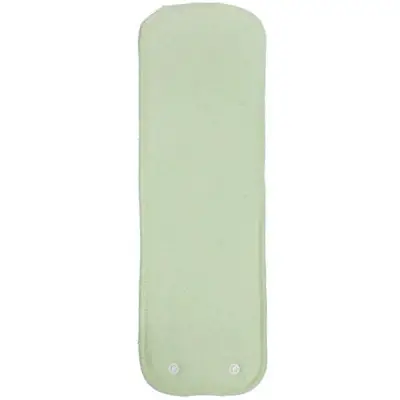
Best Bamboo Inserts
Nicki’s Diapers
Best Cloth Diaper Inserts
1. Best Bottom Hemp Cloth Diaper Inserts

Best Bottom hemp and cotton inserts are 100% natural and biodegradable. Made from certified organic hemp and cotton Best Bottom offers one of the top cloth diaper inserts for parents who wish to diaper in an eco-friendly manner.
While Best Bottom hemp inserts are designed for use with Best Bottom diaper covers or hybrids, they are versatile. Parents can also place them inside flats, prefolds, or natural diaper covers for extra absorbency.
Hemp is the thinnest and most absorbent natural fiber; however, it absorbs slower than other materials. Therefore, it’s recommended that you pair hemp under a quick-absorbing layer like cotton or bamboo diaper inserts.
To prep hemp and cotton cloth diaper inserts, you should wash them three to five times before use. Then, allow the inserts to dry between each washing completely.
What We Liked
- Options that range from birth through preschool years
- Contoured hourglass shape minimizes bulk in the middle
- Organic materials used
- Optional overnight inserts are available
- Stitching color to signify size and material for easy reference
Size: Small 11 inches long & birth-14 lbs., Medium 12.75 inches long & 11-22 lbs, Large 13.75 inches long & 16-35 lbs, XL 15.25 inches long & 26-45 lbs
Layers: 5-layers
Material: Organic hemp and cotton
Absorbency: Super absorbent, great for heavy wetters
Newborns: Small size is suitable for newborns
Suitable: Best Bottom diaper covers
2. OsoCozy Charcoal Bamboo/Microfiber Inserts

OsoCozy inserts are made from five super absorbent charcoal bamboo and microfiber layers. The combination of bamboo and microfiber gives you ultimate leak protection and incredible softness. Therefore, OsoCozy inserts are ideal heavy wetter cloth diaper inserts.
In addition, charcoal cloth diaper inserts reduce odor by inhibiting bacteria growth, and they hide stubborn stains. Plus, bamboo inserts wick moisture away, keeping your baby’s bottom dry and irritation-free.
OsoCozy’s charcoal inserts are available in two sizes. Using the smaller size prevents the bulk that accompanies most one-size inserts too big for smaller babies.
You should wash these inserts twice before using them to prep for maximum absorbency.
What We Liked
- Buying in bulk saves you money.
- Size 1 is small enough for most newborns.
- Can be tumbled dry for quicker drying times
- Work well as a standalone insert or as extra absorbency with flats and fitteds
- Ultra absorbency prevents babies from waking up from naps due to wet diapers.
Size: Two sizes: Size 1 – 1x4x11 inches and Size 2 – 1x5x13.5 inches
Layers: 5-layers
Material: 100% Bamboo & 100% Microfiber
Absorbency: Highly absorbent, great for naps and heavy wetters
Newborns: Small size is suitable for newborns
Suitable: All diaper types
3. Nicki’s Diapers One-Size Bamboo Cloth Diaper Insert

Parents love bamboo cloth diaper insert absorbency and that it is gentle on sensitive skin. Bamboo, while highly absorbent, absorbs slower than cotton.
Therefore Nicki’s DIapers combine the two making the best inserts for cloth diapers for natural diapering parents.
Natural fibers mean these inserts contain no chemicals, unwanted chemicals, or plastics; they are 100% biodegradable.
The One-size option means that these may not work as newborn cloth diaper inserts; however, once your baby is big enough, these will last several years!
You can use Nicki’s Diapers one-size inserts with snap-in diaper covers or as an added boost to flats or prefolds. These versatile inserts work as a pocket diaper insert too!
What We Liked
- 100% Natural Fibers
- Different color options
- Thin and lightweight, less bulk
- Bamboo is naturally hypoallergenic
- Bamboo is more eco-friendly than cotton
Size: 4×14 inches
Layers: Multiple layers
Material: Bamboo & Cotton
Absorbency: Super absorbent, ideal for heavy wetters
Newborns: No specific newborn size available
Suitable: All diaper types
4. Best Bottom Stay Dry Bamboo Cloth Diaper Inserts
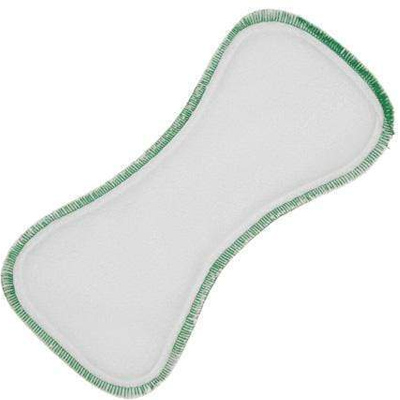
Bamboo is the best cloth diaper insert material for babies with sensitive or allergy-prone skin. Bamboo inserts for cloth diapers are naturally hypoallergenic, and bamboo restricts the growth of bacteria.
Best Bottom offers four sizes that help parents achieve the perfect fit. Parents can mix and match the size and material options until they discover the best combination for them.
Natural fibers require a bit more prep work, so you should use these a minimum of three to five times before using them. However, bamboo isn’t prone to shrinking like cotton inserts for cloth diapers, so you can tumble dry on high heat.
What We Liked
- Stitching color to signify size and material for easy reference
- Top layer of no-pill fleece quickly wicks moisture away
- Contoured hourglass shape minimizes bulk in the middle
- Buying in bulk saves you money
- Natural fibers become softer overtime
Size: Small 11 inches long & birth-14 lbs., Medium 12.75 inches long & 11-22 lbs, Large 13.75 inches long & 16-35 lbs, XL 15.25 inches long & 26-45 lbs
Layers: 6-layers
Material: Bamboo viscose topped with fleece
Absorbency: Heavy absorbency. Great baby diaper inserts for heavy wetters.
Newborns: Small size is suitable for newborns
Suitable: Best Bottom diaper covers or hybrids
5. Thirsties Stay Dry Duo Cloth Diaper Insert
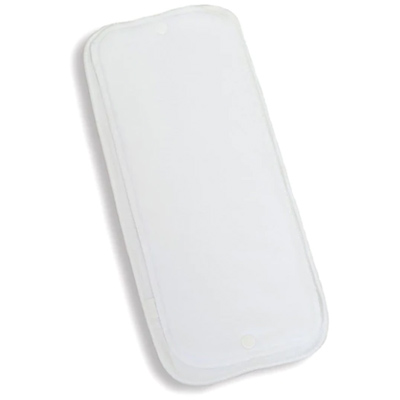
The Thirsties diaper inserts are a unique duo combination designed especially for the Thirsties Duo Wrap.
With four size options, these are among the best cloth diaper inserts for newborns but also have sizes large enough for your preschooler who is potty training.
The microfiber, hemp, and microfleece combination make these incredibly trim yet incredibly absorbent. In addition, the two layers snap together to prevent bulk and bunching.
Thirsities Stay Dry inserts require one to three washes before using for maximum absorbency. It is recommended that you hang dry these inserts, but they can be tumbled dry on low if needed.
What We Liked
- Made in the U.S.A
- Use certified organic cotton
- Can be used with a variety of diaper options
- Stay dry layer is easy to clean
- Stay dry fleece layer prevents diaper rash
Size: Size 1 – 4.5×11.75 inches & 6-18 lbs. Size 2 – 5.5×13 inches & 18-40 lbs.
Layers: 8-Layers total. Top insert 3-layers. Bottom insert 5-layers.
Material: Microfiber terry, microfleece, & jersey hemp.
Absorbency: Extremely absorbent, great for naps and overnight
Newborns: Size 1 is small enough for newborns
Suitable: Thirsties DuoWrap or pocket diapers
6. Best Bottom Newborn Stay Dry Bamboo Insert

Best Bottom Newborn inserts are the perfect beginning to your cloth diapering journey. Made specifically for newborns and relatively cheap cloth diaper inserts, parents can begin cloth diapering with some cash left in their wallets.
Best Bottom stay dry inserts have a top layer of stay-dry fleece that wicks moisture away, preventing diaper rash, and is easy to clean.
These inserts are designed for use with Best Bottom diaper covers or hybrids and snap into place to prevent slipping and bunching. In addition, the six thirsty layers absorb moisture, keeping your baby feeling dry for hours and preventing diaper rash.
What We Liked
- Specifically sized for newborns.
- Can be used with other diaper brands/styles
- Hourglass shape provides maximum comfort and less bulk.
- Line dry or tumble dry on low/medium
- Once your baby outgrows newborn size, these can be used as bonus soakers.
Size: 11 inches, 0-14 lbs
Layers: 6-Layers
Material: Bamboo viscose and no-pill fleece
Absorbency: Top absorbency, ideal for overnight
Newborns: Uniquely sized for newborns
Suitable: Best bottom diaper cover or hybrid
7. OsoCozy Bamboo Cotton Cloth Diaper Inserts
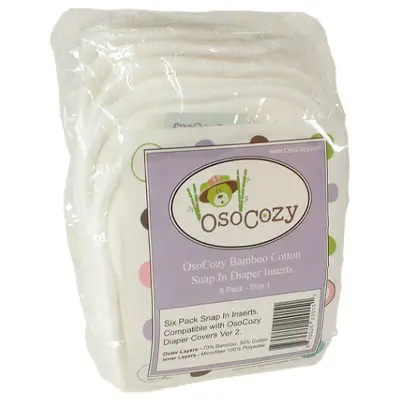
OsoCozy snap inserts are specifically designed for use with OsoCozy newborn or one-size diapers. In addition, their specialized snap-in feature means inserts stay in place, which is ideal when you have an active baby or toddler!
OsoCozy’s snap-in inserts combine the best types of cloth diaper inserts into one! The combination of cotton, bamboo, and microfiber makes these baby diaper inserts soft to the touch and incredibly absorbent.
Snap-in inserts are limited because they are made for use with compatible covers. However, if you know you like and trust OsoCozy and like the no=slipping advantage of snap inserts, these are a great choice!
What We Liked
- Buying in bulk saves you money.
- Snap-in inserts prevent slipping and bunching.
- Contoured design means less bulk in the middle
- Size 1 is small enough for newborns
- Multiple snaps provide a secure fit
Size: Size 1 – 4.75×11.75 inches (the middle is inches wide) and Size 2 – 5.75×12.75 inches (the middle is 4.75 inches wide)
Layers: 5-layers
Material: Bamboo, cotton, polyester microfiber
Absorbency: Highly absorbent, great for everyday use and naps
Newborns: Size 1 fits OsoCozy Newborn diaper covers
Suitable: OsoCozy One-Size Diaper Covers
8. Buttons Nighttime Cloth Diaper Inserts
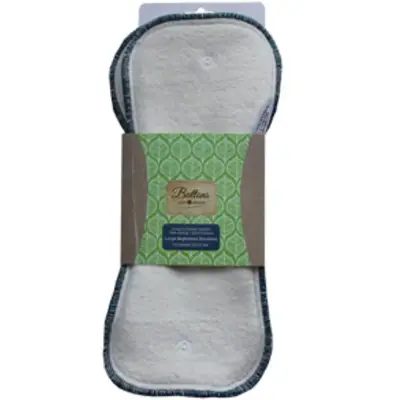
Buttons’ Nighttime inserts are absorbent and designed with a snap-in feature to keep them in place. One snap at each end of the inserts provides a snug and secure fit.
These unique nighttime inserts are among the best diaper inserts for nighttime use. Designed explicitly for overnight, they wick and hold moisture away from your baby’s bottom.
Since microfiber diaper inserts cannot be placed directly next to your baby’s skin, you must place a daytime insert on top.
Microfiber is one of the most absorbent fabrics for cloth diapers. Therefore, it is ideal for nighttime use; however, it is rough and abrasive to the skin.
What We Liked
- Multiple sizes and fabrics are available.
- Stitching color to signify size and material for easy reference
- Parents rate them as among the most absorbent cloth diaper inserts
- High-level absorbency prevents leaks
- Snap-in inserts prevent slipping and bunching
Size: Two Sizes: Small 9-20 lbs, Large 20-35 lbs
Layers: 5-layers
Material: Two Options: Microfiber or Hemp/Cotton
Absorbency:
Newborns: Specific newborn sizing is not available
Suitable: Buttons One-size diaper covers
9. Charlie Banana Reusable Fleece Inserts
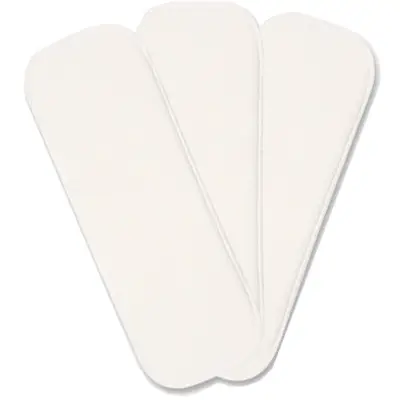
Charlie Banana reusable diaper inserts are soft, absorbent, and easy to clean, making them one of the best diaper inserts available. Sold in sets of three and built to last, these cloth inserts are an affordable choice.
Charlie Banana inserts are some of the best diaper inserts for nighttime because they are highly absorbent. Made with ultra-absorbent microfiber and topped with fluffy fleece, these inserts are safe and gentle on your baby’s skin.
Parents love how they stay soft wash after wash and quickly wick moisture away, keeping their babies dry.
Once soiled, toss in your diaper bin and wash every two to three days on cold or warm.
What We Liked
- 1% of sales are donated to environmental causes
- OEKO-TEX Certified
- Versatile and thin enough to double for maximum absorbency.
- Hang dry or tumble dry on low
- Fleece lining means inserts can go directly against your baby’s skin.
Size: Two sizes: Small 11.8”x 4.7” Med/Lg 13”x4.7”
Layers: Multiple Layers
Material: 100% Polyester microfiber & polyester fleece
Absorbency: Maximum absorbency, excellent for heavy wetters
Newborns: Specific newborn sizing is not available
Suitable: Pocket diapers, hybrids, or with diaper covers
10. Charlie Banana Reusable Hemp Inserts

Charlie Banana hemp reusable diaper inserts are an eco-friendly alternative to all polyester options.
The top layer is made from 55% hemp and 45% cotton, providing ultimate softness. Underneath are multiple layers of polyester fabric to up the absorbency over 100% hemp diaper inserts.
Available in two sizes to grow with your baby. If you are experiencing leaks, pair large and small inserts together for added protection.
Parents love the thickness of Charlie Banana hemp diaper inserts, and they stay soft and absorbent in use after use. The hemp, cotton, and microfiber combo makes these cloth diaper inserts for heavy wetters.
What We Liked
- 1% of sales are donated to environmental causes
- Made from all-natural materials
- Hemp and cotton are both biodegradable
- Two size options make finding the perfect fit easy.
- Simple to wash and dry
Size: Two sizes: Small 11.8×4.7 inches Med/Lg 13×4.7 inches
Layers: Multiple layers
Material: Hemp and cotton blend
Absorbency: Maximum absorbency, great for overnight
Newborns: Specific newborn sizing is not available
Suitable: Pocket diapers, hybrids, or with diaper covers
11. Charlie Banana Disposable Cloth Diaper Inserts
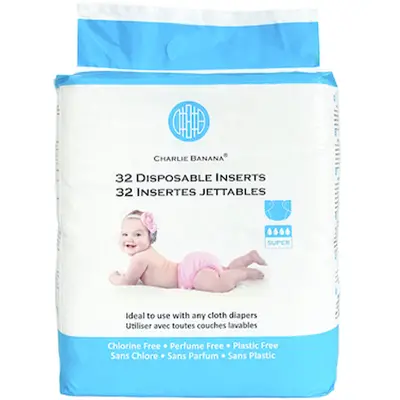
Disposable inserts are a lifesaver when traveling or running errands. And Charlie Banana disposable cloth diaper inserts will set your mind at ease since they are made from 100% natural bamboo.
Not only is bamboo biodegradable, but it uses fewer natural resources to grow than cotton and regenerates much faster!
When combined with waterproof diaper covers, disposable liners are popular cloth diaper inserts for child care. All your caregiver needs to do is toss out the old liner, wipe down the diaper cover and place a new liner inside the cover!
These liners are absorbent but not ideal for nighttime use. However, all you need to do is pair one with a reusable insert for maximum absorbency.
What We Liked
- 1% of sales are donated to environmental causes
- An economical and practical option for traveling
- Lightweight and absorbent
- Plastic and perfume free
- Eco-friendly disposable option
Size: 4.5 inches wide x 10.5 inches long
Layers: 2-layers
Material: 100% bamboo rayon
Absorbency: Highly absorbent, best for daytime use
Newborns: Specific newborn sizing is not available
Suitable: All diaper types, great for travel
12. KangaCare Rumparooz Microfiber Cloth Diaper Insert

KangaCare microfiber inserts for cloth diapers are designed for use with hemp or bamboo doubler for maximum absorbency. They are also designed to be used in both directions to provide the ultimate protection for boys and girls.
When used with a hemp or bamboo doubler, you get six layers of absorbency! Parents love these diaper inserts for overnight because microfiber is so highly absorbent.
Microfiber quickly wicks moisture away and can absorb seven times its weight! Microfiber is one of the best inserts for pocket diapers because of its ability to lock in moisture.
And since microfiber cannot go directly against your baby’s skin, using it with pocket diapers is ideal.
What We Liked
- Each soaker set includes a full-size and contoured insert.
- Microfiber is more affordable than most natural inserts
- Microfiber only needs one wash before using
- Machine wash and dry on low
- Great leak prevention
Size: 11.5×8 inches or 6lbs to 40 lbs
Layers: 3- layers
Material: 100% Microfiber
Absorbency: Highly absorbent, one booster suitable for daytime use
Newborns: Small enough for newborns
Suitable: KangaCare Pocket diapers or other pocket diaper style
Inserts vs. Doublers vs. Liners
Inserts, doublers, and liners are all terms cloth parents toss around. Inserts are the absorbent layer that wicks moisture away. Doublers are a second insert of varying sizes or materials added to boost absorbency.
Finally, liners are a thin layer, usually disposable, to protect diapers from creams and messy poops, and added as an additional stay-dry layer.
Inserts
Inserts are typically made from microfiber, cotton, hemp, or bamboo. Microfiber makes the best pocket diaper insert because it is highly absorbent but cannot be placed directly next to the skin. Sew or check out sites like Etsy. You can make or purchase zorb diaper inserts which offer the benefits of microfiber but are gentle on your baby’s skin.
Doublers
Doublers are a second insert you add to boost the diaper’s absorbency. Many parents choose to pair natural inserts like cotton, bamboo, or hemp with microfiber underneath. Natural fibers are better for the environment and safe for your baby’s delicate skin.
Liners
Liners make cleaning up messes a cinch. The best disposable inserts for cloth diapers are flushable because you don’t need a second diaper pail to toss messy poop. However, the ones you can fold up and toss are life-savers for traveling and errands.
Types of Cloth Diaper Inserts
There are several different shapes and styles of diaper inserts. Some are all-natural, others are disposable, and some are better suited to boys or girls. The shape and material play a crucial role in how absorbent an insert is and which type of diaper it best suits.
Pad
Pad style liners are the most commonly used type of diaper insert. Pad liners consist of multiple layers of fabric sewn together to create a thick, rectangular pad. Pad inserts are compatible with any style of cloth diaper. Pad inserts work best for parents who aren’t sure which style of cloth diaper they plan to use because they are the most versatile.
Prefold
A prefold is a flat diaper that has been folded and sewn into a padded shape with maximum absorbency in the middle. They can be used as an insert or on their own with a waterproof diaper cover.
Trifold
Trifolds are ideal for heavy wetters. These wide inserts are folded into thirds, tripling the absorbency. Typically used with pocket diapers, they also work with hybrid diapers or as an added layer with flats and prefolds.
Flat
Flats are large pieces of fabric that your shape into a diaper or can fold into a padded layer for the middle of the diaper. You can use flats with diaper pins and a waterproof cover or as an added layer with other styles of diapers.
Petal Style
A petal insert is two or more layers of absorbent fabric that either snap together or are sewn together at one end. Because the layers peel open like a flower, they dry quicker. Petal inserts are not common. However, they tend to be all-natural fabrics, so they may be ideal for parents wishing to avoid synthetics.
Snake Style
Snake inserts are two to three layers of fabric sewn together in a long strip. They are used by folding in half or folding accordion style. Snake style inserts are pretty uncommon, but you could make them yourself or purchase them from a craft site such as Etsy if you prefer this style.
Soakers
Soakers are inserts that snap or attach to the inside of a hybrid or all-in-one diaper. Soakers are typically made from natural fibers since they touch your baby’s skin. Although in some instances, microfiber will be sandwiched between two all-natural layers.
Common Insert Materials
Diaper inserts are made from a wide range of natural and synthetic fabrics. Each textile has benefits and drawbacks. Blended inserts are popular because they offer parents the benefits of many fabrics in one product.
Bamboo
Bamboo is one of the most popular textiles for diaper inserts. It’s ideal for babies with sensitive skin because it’s gentle and hypoallergenic. It’s absorbent but absorbs slowly, so it’s common to pair bamboo with cotton or microfiber.
Cotton
Cotton is a standard textile used for diaper inserts, mainly organic cotton. Cotton is soft and delicate on your baby’s skin and resilient and durable. A bonus is that cotton becomes softer with each wash. Cotton and cotton blends are a top pick for parents who want natural materials and heavy absorbency.
Hemp
Hemp has become a popular choice for diaper inserts because it is incredibly absorbent yet thin and lightweight. In addition, hemp is antimicrobial, and it can absorb more than twice what microfiber can. As a result, hemp combined with microfiber is an excellent choice for heavy wetters and overnight.
Microfiber
Microfiber is the common choice for pocket diapers or a bottom layer to boost absorbency. Microfiber is made from polyester. While super absorbent, it is scratchy and abrasive to the skin, so it needs a layer on top. You can also use microfiber on the bottom when cloth diapering with disposable inserts.
Minky
Minky is a luxuriously soft polyester fabric that is soft and gentle. Unlike microfiber, this type of polyester is safe to touch your baby’s skin. Minky diaper inserts can be difficult to find; however, you can make them yourself if you know how to sew.
Zorb
Zorb is another fabric not commonly used commercially for diaper inserts, but many DIY parents make them for their babies. You can also purchase them online from sites like Etsy. Zorb is an amalgam fabric made from bamboo, cotton, and polyester. It is incredibly absorbent and absorbs ten times its weight! It’s a great fabric for heavy wetters.
Velour
While it is common to find velour cloth diaper covers, velour inserts are less widely available. Velour fabric is made to feel like velvet and is usually made from cotton or polyester. It is a soft, luxurious material and typically isn’t very moisture-wicking.
FAQ
What are cloth diaper inserts?
Cloth diaper inserts are padded lengths of fabric added to cloth diapers to increase the diaper’s absorbency. They are made from natural and synthetic materials.
Can you use prefolds as inserts?
Yes. It is quite common for parents to use prefold diapers as inserts. They can be folded and shaped to meet your absorbency needs.
What are cloth diaper inserts made of?
The most common materials for cloth diaper inserts are bamboo, cotton, hemp, and microfiber. Although many have a no-pill microfleece layer, you can also find them made from Minky, Zorb, and velour.
What are the best cloth diaper inserts?
It depends on your needs. Heavy wetters may do best with hemp or microfiber while babies with sensitive skin might prefer bamboo. It also depends on your diaper style.
What type of hemp is used in cloth diaper inserts?
Industrial hemp is used to make cloth diapers and inserts. Industrial hemp is a grade of cannabis sativa specifically for use in textiles and fabrics.
How many cloth diaper inserts do I need?
On average you need 2-3 inserts for every diaper or diaper cover you have. On average you should have 24-36 cloth diapers so double or triple that for the amount of inserts you need. It will vary slightly depending on your baby and diaper style.
How often do you change cloth diaper inserts?
Diaper inserts or cloth diapers should be changed every 1-2 hours for a newborn and every 2-3 hours for an older baby. If the insert is not soiled or wet it does not need to be changed.
How to use cloth diapers with inserts?
Your diaper style will determine how you use diaper inserts. Some inserts are stuffed into pockets while others are snapped into place. With many diaper styles you simply lay the insert inside of the diaper.
How to make cloth diaper inserts?
If you sew, there are many tutorials online for DIY inserts. While you could sew them by hand, a machine will be more efficient and faster.
How to layer cloth diaper inserts?
If using microfiber it must always go beneath another layer or inside a pocket. When using two inserts, place the larger insert on the bottom and the smaller centered on the top.
How to dry cloth diaper inserts?
It is always best to follow the manufacturer’s recommendations. In most cases line drying is best, however many styles can be tumbled dry on low or medium.
How to prep cloth diaper inserts?
Natural inserts need a minimum of 3-5 washes before using. Allow the inserts to dry completely between each wash. Microfiber inserts typically only require one pre-wash.
How to fold cloth diaper inserts?
Diaper inserts can be folded in half, thirds, or accordion style. The most absorbent or padded section should be in the middle.
How to make cloth diaper inserts with Zorb?
You can purchase Zorb online or from your favorite fabric seller. Follow a DIY tutorial to cut and sew the diaper insert style of choice. You will need 3-5 layers of fabric per insert.
How to get stains out of cloth diaper inserts?
The sun will naturally bleach most stains out of inserts. Rinsing and pre-soaking can also help remove stains. You can use a laundry booster like Oxi-clean but check with the insert manufacturer before using it to make sure it won’t damage the fabric.
How to use microfiber cloth diaper inserts?
Microfiber should be placed in a pocket diaper or under a reusable or disposable diaper insert or liner. Microfiber is not safe to touch your baby’s skin as it can cause irritation.
Which is better: hemp vs bamboo inserts?
It depends on your needs. Hemp is more absorbent and thinner than bamboo but takes much longer to dry and is not as durable. Both styles work best when paired with cotton or microfiber.
Which is better: microfiber vs bamboo diaper inserts?
It depends on your needs. Bamboo absorbs more liquid than microfiber but at a much slower rate. Bamboo is an all natural material whereas microfiber is polyester.
When should you throw away cloth diaper inserts?
If they are stained and smell or if they have stopped absorbing and you are experiencing frequent leaks. However, always try stripping them first.
When to use cloth diaper inserts?
Diaper inserts are used with most styles of cloth diapers. Even all-in-one diapers might need an added layer of absorbency overnight. Typically one insert for day and two at night works for most parents.
Which cloth diaper inserts are most absorbent?
Microfiber, hemp, and bamboo are the top three absorbent materials. However they all absorb at varying rates. All three work best with an added layer or with a stay-dry fleece layer on top to keep baby dry.
How many cloth diaper inserts for 1 year old
A one-year-old has approximately 6-8 diapers a day and should have enough diapers for 2-3 days. You need three inserts per diaper, so you will need roughly 50-60 inserts.
How long do cloth diaper inserts last?
Cloth diaper inserts can last for years when properly cared for. Many parents use the same set of inserts for two or three children.

L. Elizabeth Forry
L. Elizabeth Forry is an Early Childhood Educator with fifteen years of classroom teaching experience. She earned a Master of Science in Early Childhood Education from The University of North Dakota and has a Bachelor of Arts in English and one in Music from Lebanon Valley College. She has taught children in Japan, Washington D.C., Chicago, and suburban Maryland. She is trained as a reading therapist, has a TEFL certification, and has done extensive work with children regarding mental health, social-emotional development, and gender development. She has written curriculum for children and educators and has led training sessions for parents and educators on various topics on early childhood development. She is the mother of two boys and resides outside of Annapolis, Maryland.

